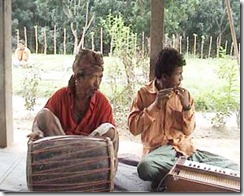Print  |
|


Jadu Kolija, the core of Kokborok culture and language
Posted by Joseph Pulinthanath on December 7, 2011
By Salesian Father Joseph Pulinthanath, Director of the film Yarwng (Roots), made in Kokborok language, in the Indian state of Tripura.

Tripura-Kokborok
Kokborok language, like its speakers, seems to be critically poised at some crossroads of history. Strewn about the length of breadth of this hallowed land of erstwhile kings and kingdoms are numerous signs of resurgence and decadence.
Caught in the middle, between two worlds – one dead, the other powerless to be born, is a tongue, crisis-ridden yet buoyant: Kokborok, the mother-tongue of the ‘borok’ people of Tripura in Northeast India.
Vicissitudes of history have relegated the language and its speakers to the fringes of society, although it is still used by over 800 000 speakers. Today’s efforts at rejuvenation of the tribe and its language are characterized by muddled policies and half-hearted attempts.
The revival of Kokborok
Recent efforts at revitalizing Kokborok have been phenomenal. In fact, the sheer pace with which Kokborok reinvented itself in the past 20 years is amazing.
There was a time not long ago, when Kokborok was spoken in hushed tones in Agartala. This was because enmeshed in socio-political factors Kokborok got absurdly equated with lack of education, status and breeding.
But that was all a long time ago! The scenario has substantially changed today. The sotto voce asides of yesteryears have now been replaced by confident assertions. Today one frequently gets to hear Kokborok in public places and occasions even in the towns of Tripura. The increased level of confidence and ease with one’s tongue is reflected in all public spheres of life. There are numerous Kokborok festivals, Kokborok songs, films, theatre, workshops, websites, seminars and Kokborok-related activities in the state. There is even a state-sponsored ‘Kokborok Day’ celebrated annually in the state. It is, of course, another matter that with Kokborok itself seldom featuring in it, the annual event is quickly beginning to feel like a memorial function ‘about’ Kokborok.
The decline of Jadu Kolija
These laudable efforts and their achievements should encourage and not prevent the community from seriously engaging Kokborok’s own timeless ‘art’ called Jadu Kolija. Jadu Kolija literally means ‘heart of the beloved’ or ‘from the heart for the beloved’. It embraces not only love songs but all traditional form of singing/chanting.
Today, Jadu Kolija is seldom heard and indulged in. It is a pity that native speakers have bypassed this fount of wealth in their pursuit of the new brave world. This is a submission that efforts at resurgence of Kokborok, which are anyway few and far between, must not shy away from seriously engaging the ‘vital founts’ of its culture like Jadu Kolija, if they are to impact the community in a lasting manner. Sidestepping these ‘founts’ will, in the course of time, render these already feeble attempts, altogether futile or merely cosmetic at best.
I have always felt that the extraordinary richness of Kokborok language is best found in this traditional art form of the tribal community. The profound meaning of its arresting lyrics and their haunting tunes continue to enchant even today. In a manner seldom understood by non-Kokborok speakers this enigmatic music tradition held absolute sway over the entire life-cycle of the person and the community. Jadu Kolija enveloped all significant moments and events of the life-cycle. It was theatre, music and morality all rolled into one.
Still, no progress without Jadu Kolija
The thought that ‘Kokborok’ language might be ‘endangered’ is a disquieting one for me. For the past 17 years my ears have fed on the enigmatic sounds of this language. With each passing year, my ears tell me that the best of Kokborok is yet to come.
Jadu Kolija is an irresistible mixture of the rational and the emotional – the head and the heart. The stunning imageries and resonant metaphors found in Jadu Kolija can uplift not only a language but a people. The lyrics of Jadu Kolija with their untranslatable meanings, moods and innuendo can continue to be the life-giving veins of the Kokborok culture. It has the ability to ensure that the Kokborok-speaking community stays rooted on the earth and yet has its eyes fixed on the stars. Effort to restore and revitalize Kokborok without according Jadu Kolija even scant attention has a ring of absurdity about it.
To ensure the future of kokborok culture and language, ways must be devised to restore Jadu Kolija to the community. A people that have for decades been deluded by unvoiced agendas of vested interest groups should easily realize the need there is for passion to replace intellectual gimmicks. Until Kokborok speakers are seized by a passion to return to the best fount of their language, Jadu Kolija, the famed resilience of the Kokborok tribe would continue to lack depth and character. In the resurgence of Jadu Kolija lies the secret to preservation of Kokborok.








